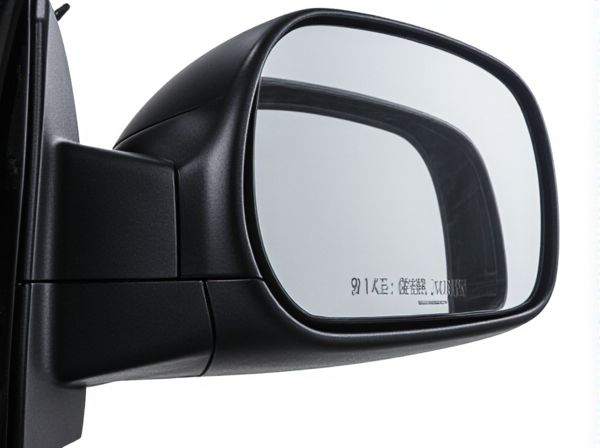
Photo illustration: Power-adjustable Mirror vs Manual-adjustable Mirror
Power-adjustable mirrors offer precise control with the push of a button, enhancing convenience and safety by allowing you to quickly adapt to changing driving conditions. Manual-adjustable mirrors require physical adjustment, which can be less accurate and more time-consuming, especially while on the move. Your choice impacts comfort and ease of use, particularly in vehicles shared by multiple drivers or frequently used in varied environments.
Table of Comparison
| Feature | Power-adjustable Mirror | Manual-adjustable Mirror |
|---|---|---|
| Adjustment | Electric motor controls, adjusted via switch/button | Physical hand or lever adjustment |
| Convenience | High - quick, precise, on-the-go adjustments | Low - requires stopping and manual effort |
| Cost | Higher initial cost and repair | Lower upfront and maintenance cost |
| Durability | More components, susceptible to electrical failure | Fewer parts, generally robust |
| Common Use | Modern cars, luxury and mid-range vehicles | Older models, economy and base trim cars |
| Additional Features | May include heating, auto-dimming, memory settings | Basic mirror function only |
Introduction to Car Mirror Adjustability
Power-adjustable mirrors enable drivers to modify mirror positions electronically from inside the vehicle, offering convenience and precision, especially while driving. Manual-adjustable mirrors require physical adjustment by hand, typically outside the vehicle, which can be less efficient and less safe when needing quick changes. Modern vehicles increasingly feature power-adjustable mirrors to enhance driver visibility and overall safety through ease of use and accurate positioning.
What Are Power-Adjustable Mirrors?
Power-adjustable mirrors are side mirrors on vehicles that can be electronically adjusted using controls inside the car, allowing drivers to customize mirror angles without physically moving the mirror glass. These mirrors often include additional features such as heating elements to prevent fogging and automatic folding mechanisms for convenience and protection. Compared to manual-adjustable mirrors, power-adjustable versions enhance driver safety and comfort by providing precise, easy-to-reach adjustments.
What Are Manual-Adjustable Mirrors?
Manual-adjustable mirrors require physical effort to change their position, typically using a lever or knob located inside the vehicle. These mirrors lack electronic motors and depend entirely on driver manipulation for adjustment. They offer a cost-effective option but may not provide the precision and ease of power-adjustable mirrors.
Key Differences Between Power and Manual Mirrors
Power-adjustable mirrors use electric motors to enable easy, remote adjustment of mirror angles, improving convenience and precision compared to manual-adjustable mirrors, which require physical manipulation. Power mirrors often integrate features like heating, auto-dimming, and memory settings, enhancing safety and comfort, whereas manual mirrors typically lack these advanced functionalities. Manual mirrors are generally more affordable and simpler in design but require driver effort to adjust, making power-adjustable mirrors the preferred choice in modern vehicles for enhanced usability and functionality.
Installation and Maintenance Comparison
Power-adjustable mirrors typically require more complex installation due to wiring and compatibility with the vehicle's electrical system, often necessitating professional assistance. Manual-adjustable mirrors have simpler installation processes, involving basic mechanical adjustments without electrical connections, making them easier to maintain. Maintenance of power mirrors can be more costly and time-consuming due to electrical components, whereas manual mirrors generally require minimal upkeep and straightforward repairs.
Cost Analysis: Power vs Manual Mirrors
Power-adjustable mirrors generally cost between $150 and $300 per mirror, reflecting higher manufacturing and installation expenses due to integrated motors and electrical components. Manual-adjustable mirrors are significantly cheaper, often priced between $30 and $70, making them a cost-effective option for budget-conscious consumers. While power mirrors offer enhanced convenience and functionality, manual mirrors provide essential features at a lower upfront investment and reduced repair costs.
User Experience and Convenience
Power-adjustable mirrors offer effortless customization with electronically controlled settings, enabling precise angle adjustments from inside the vehicle, which significantly enhances user convenience and safety. Manual-adjustable mirrors require physical manipulation, often needing the driver to reach outside or struggle with awkward positioning, reducing ease of use during driving. The power-adjustable option also typically includes memory settings for multiple drivers, further streamlining user experience and minimizing distraction.
Safety Features and Performance
Power-adjustable mirrors offer enhanced safety features by enabling quick and precise adjustments from inside the vehicle, reducing driver distraction and ensuring optimal rear visibility. These mirrors often include integrated heating elements and automatic dimming functions that improve performance in adverse weather and low-light conditions. In contrast, manual-adjustable mirrors require physical adjustments, which can delay proper positioning and compromise safety and convenience during driving.
Which Mirror Type Suits Your Needs?
Power-adjustable mirrors offer precise, effortless angle control via electronic switches, ideal for drivers seeking convenience and frequent mirror adjustments. Manual-adjustable mirrors require physical movement for adjustments, suiting budget-conscious users or those preferring simplicity without electrical components. Assess your driving habits, vehicle features, and personal preferences to choose between the technological ease of power-adjustable mirrors and the straightforward reliability of manual-adjustable models.
Conclusion: Making the Right Choice for Your Vehicle
Power-adjustable mirrors offer convenience, precision, and ease of use, making them ideal for modern vehicles and drivers who prioritize quick adjustments and safety. Manual-adjustable mirrors provide a cost-effective and simple solution, suitable for budget-conscious vehicle owners or those seeking minimal maintenance. Choosing the right mirror depends on your driving habits, budget, and preference for technology integration in your vehicle.
 caratoz.com
caratoz.com